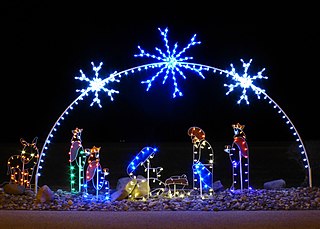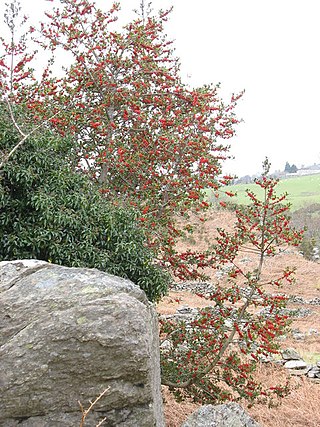
Christmas is an annual festival commemorating the birth of Jesus Christ, observed primarily on December 25 as a religious and cultural celebration among billions of people around the world. A liturgical feast central to Christianity, preparation for Christmas begins on the First Sunday of Advent and it is followed by Christmastide, which historically in the West lasts twelve days and culminates on Twelfth Night. Christmas Day is a public holiday in many countries, is observed religiously by a majority of Christians, as well as celebrated culturally by many non-Christians, and forms an integral part of the annual holiday season.

The Wheel of the Year is an annual cycle of seasonal festivals, observed by a range of modern pagans, marking the year's chief solar events and the midpoints between them. Modern pagan observances are based to varying degrees on folk traditions, regardless of the historical practices of world civilizations. British neopagans popularized the Wheel of the Year in the mid-20th century, combining the four solar events marked by many European peoples, with the four midpoint festivals celebrated by Insular Celtic peoples.

Euphorbia is a large and diverse genus of flowering plants, commonly called spurge, in the family Euphorbiaceae.

Mistletoe is the common name for obligate hemiparasitic plants in the order Santalales. They are attached to their host tree or shrub by a structure called the haustorium, through which they extract water and nutrients from the host plant.

The poinsettia is a commercially important flowering plant species of the diverse spurge family Euphorbiaceae. Indigenous to Mexico and Central America, the poinsettia was first described by Europeans in 1834. It is particularly well known for its red and green foliage and is widely used in Christmas floral displays. It derives its common English name from Joel Roberts Poinsett, the first United States minister to Mexico, who is credited with introducing the plant to the US in the 1820s. Poinsettias are shrubs or small trees, with heights of 0.6 to 4 m. Though often stated to be highly toxic, the poinsettia is not dangerous to pets or children. Exposure to the plant, even consumption, most often results in no effect, though it can cause nausea, vomiting, or diarrhea.

A wreath is an assortment of flowers, leaves, fruits, twigs, or various materials that is constructed to form a ring shape.

Ilex opaca, the American holly, is a species of holly, native to the eastern and south-central United States, from coastal Massachusetts south to central Florida, and west to southeastern Missouri and eastern Texas.

The observance of Christmas around the world varies by country. The day of Christmas, and in some cases the day before and the day after, are recognized by many national governments and cultures worldwide, including in areas where Christianity is a minority religion which are usually found in Africa and Asia. In some non-Christian areas, periods of former colonial rule introduced the celebration ; in others, Christian minorities or foreign cultural influences have led populations to observe the holiday.

A Christmas decoration is any of several types of ornamentation used at Christmas and the greater Christmas and holiday season. The traditional colors of Christmas are pine green (evergreen), snow white, and heart red. Gold and silver are also prevalent, as are other metallic colours. Typical images on Christmas decorations include Baby Jesus, Mother Mary, angels, Father Christmas, Santa Claus, and the star of Bethlehem. Advent wreaths, nativity scenes, illuminations, and Moravian stars are popular Christmas decorations.

"The Holly and the Ivy" is a traditional British folk Christmas carol, listed as number 514 in the Roud Folk Song Index. The song can be traced only as far as the early nineteenth century, but the lyrics reflect an association between holly and Christmas dating at least as far as medieval times. The lyrics and melody varied significantly in traditional communities, but the song has since become standardised. The version which is now popular was collected in 1909 by the English folk song collector Cecil Sharp in the market town of Chipping Campden in Gloucestershire, England, from a woman named Mary Clayton.

Viscum album is a species of mistletoe in the family Santalaceae, commonly known as European mistletoe, common mistletoe, or simply as mistletoe. It is native to Europe as well as to western and southern Asia. V. album is found only rarely in North America, as an introduced species.
Festive ecology explores the relationships between the symbolism and the ecology of the plants, fungi and animals associated with cultural events such as festivals, processions, and special occasions. Examples of topics are given below.

Ilex decidua is a species of holly native to the United States.

Christmas in Ireland is the annual festival which marks the Christian celebration of the birth of Jesus and its related observances, but also incorporates some pre-Christian customs. These customs range from the traditional food and drink consumed, decorations and rituals, as well as more modern phenomena such as the Christmas day swim and annual television and radio events. The modern Irish Christmas has become more similar to that of the British and American festive period, with emphasis on gift buying and parties.

Phoradendron leucarpum is a species of mistletoe in the Viscaceae family which is native to the United States and Mexico. Its common names include American mistletoe, eastern mistletoe, hairy mistletoe and oak mistletoe. It is native to Mexico and the continental United States. It is hemiparasitic, living in the branches of trees. The berries are white and 3–6 millimeters (0.12–0.24 in). It has opposite leaves that are leathery and thick. Ingesting the berries can cause "stomach and intestinal irritation with diarrhea, lowered blood pressure, and slow pulse". This shrub can grow to 1 meter (3.3 ft) by 1 meter (3.3 ft).

Ilex or holly is a genus of over 570 species of flowering plants in the family Aquifoliaceae, and the only living genus in that family. Ilex has the most species of any woody dioecious angiosperm genus. The species are evergreen or deciduous trees, shrubs, and climbers from tropics to temperate zones worldwide. The type species is Ilex aquifolium, the common European holly used in Christmas decorations and cards.

The history of flower arrangement dates back to ancient Egyptian times.
Christmas plants are flowers or vegetation from garden plants associated with the festive season of Christmas. There are also a wide variety of plants that include "Christmas" in their common name.

Christmas in Mexico is observed from December 12 to January 6, with one additional celebration on February 2. Traditional decorations displayed on this holiday include nativity scenes, poinsettias, and Christmas trees. The season begins with celebrations related to the Virgin of Guadalupe, the Patroness of Mexico, followed by traditions such as Las Posadas and Pastorelas.

Christmas traditions include a variety of customs, religious practices, rituals, and folklore associated with the celebration of Christmas. Many of these traditions vary by country or region, while others are practiced virtually identically worldwide.

















